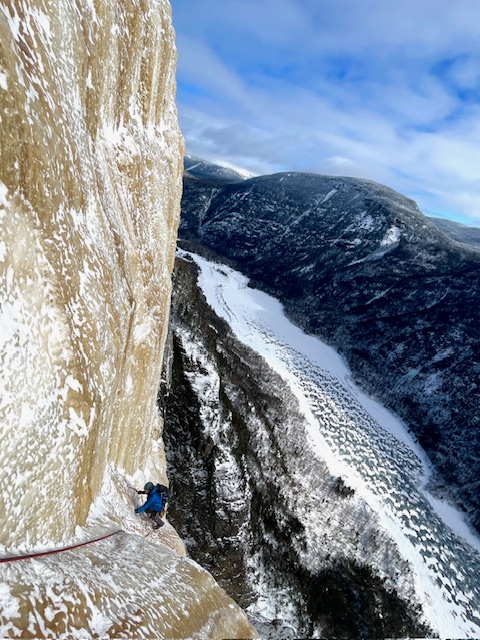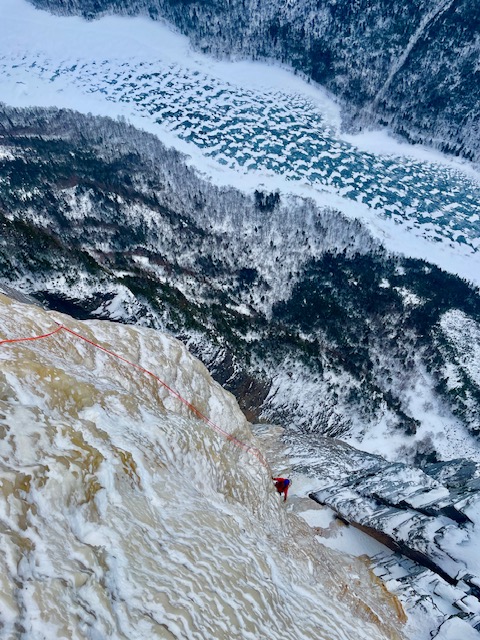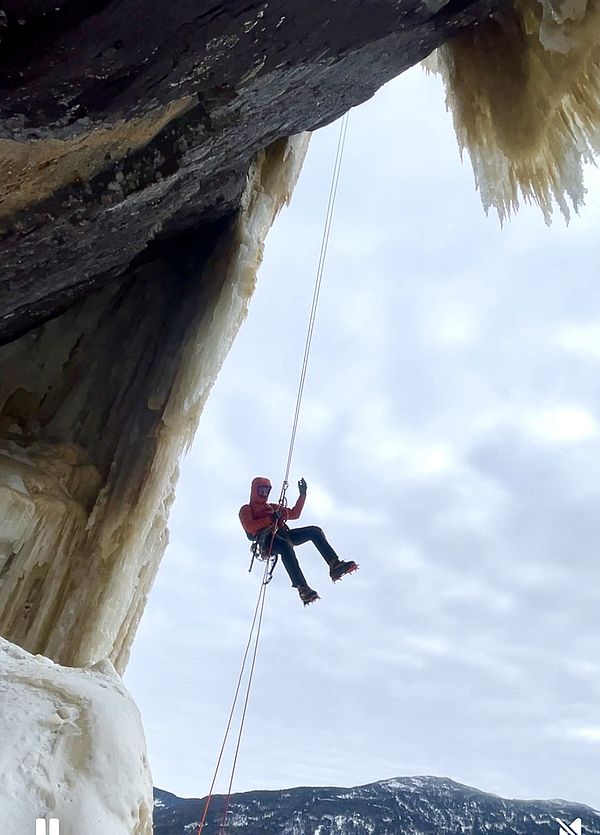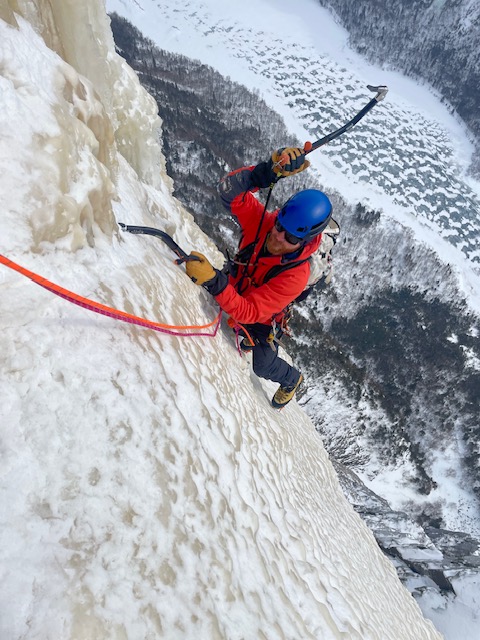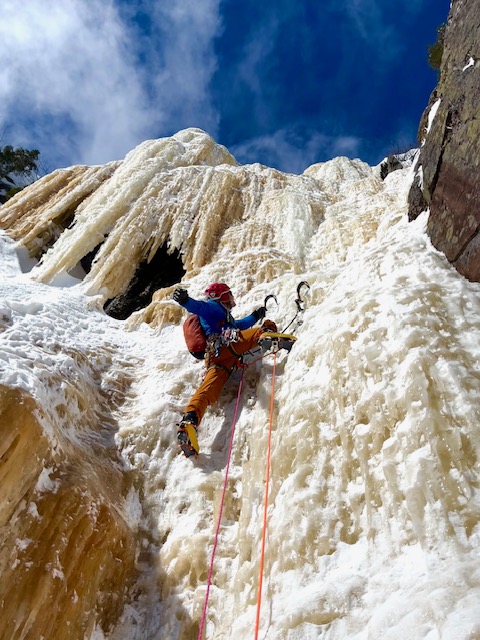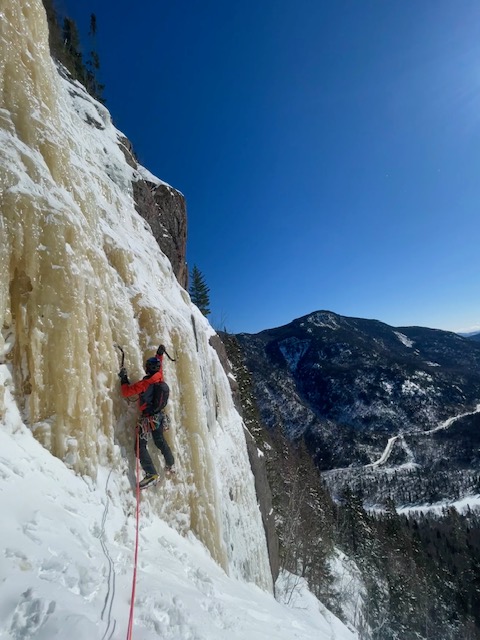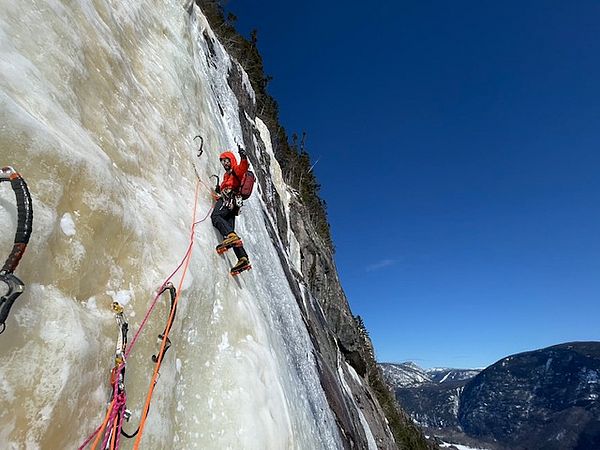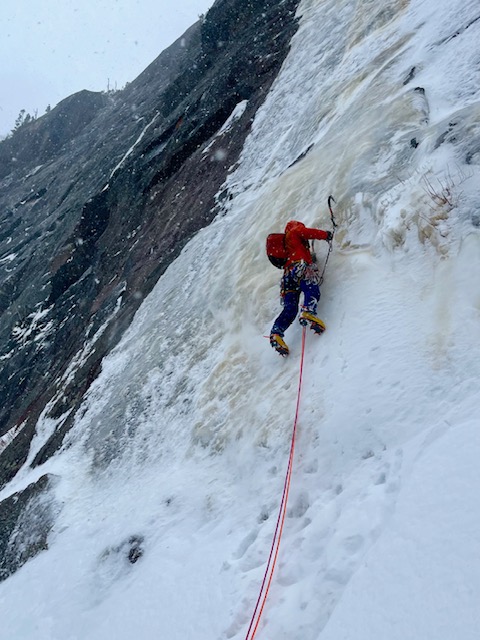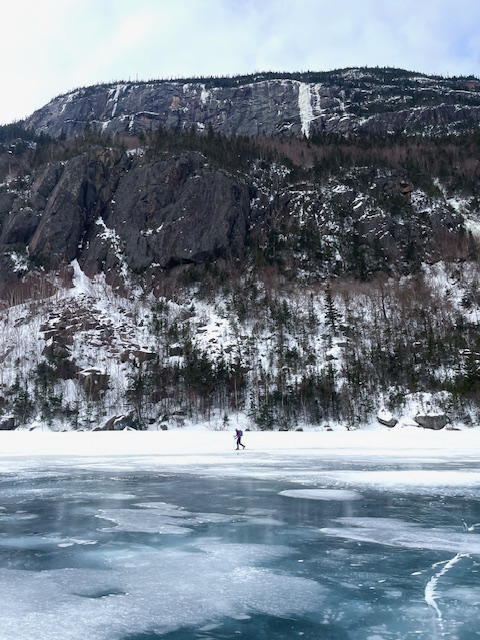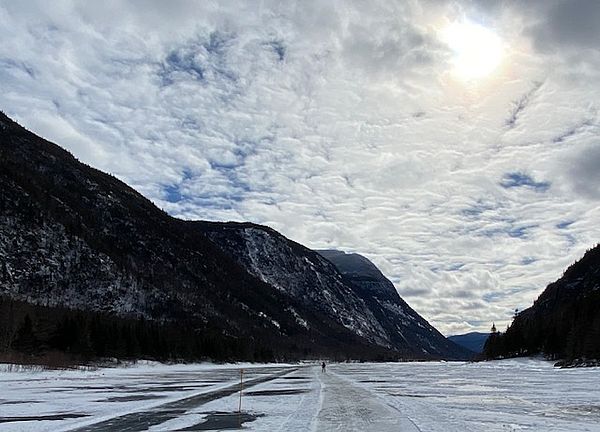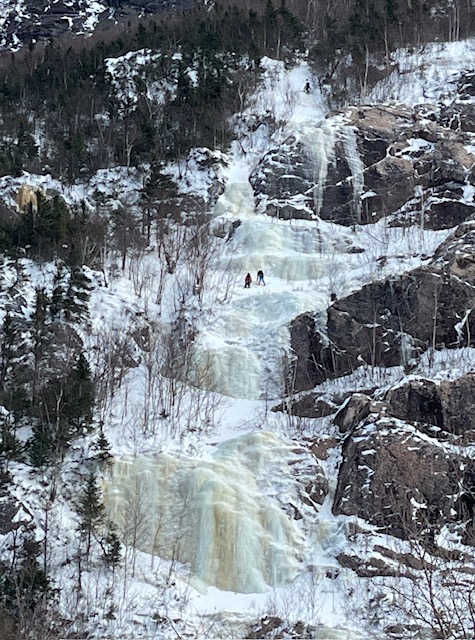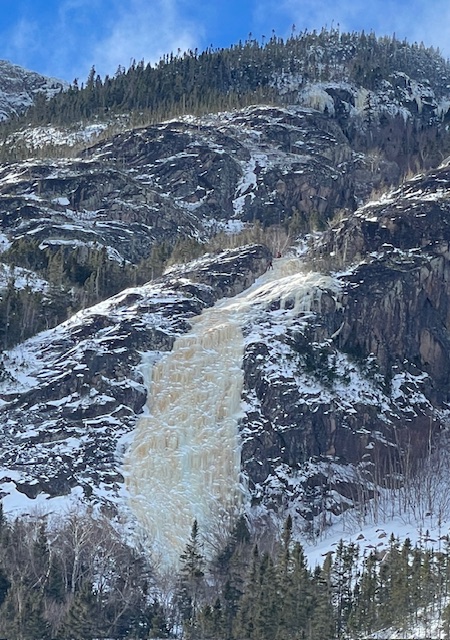It was another incredible season in Quebec's Hautes Gorges. Last year, I'd written a blog post (March 3, 2024) with information and reflections on climbing in this area. This post is a bit of an update on that post, based on my 5 climbs of Pomme d'Or, 4 climbs of La Triolet, and 2 climbs of Lavoie Papy this season. It has more complete and specific information regarding lodging, approach information, and climbing and rappel information.
Lodging
Staying at La Maison du Bootleggers “Presbytere” lodging is a great bet. It can be found on AirBnB, hosted by Johann. The place is a large building with private rooms, some with private bathrooms, and then a large kitchen, dining, and living room area. It is also about as close to the park as you'll likely find lodging. As noted in my previous blog post, this can be a great lodging option. However, do be aware that on Fridays & Saturdays, the kitchen is locked at night, which can make early morning starts inconvenient. If you're staying here on a Saturday or Sunday, you'll have to plan your alpine starts accordingly, with all your food in your packs and some kind of a plan for hot liquids in the morning.
Parc Headquarters
It is about 40 minutes drive to the Parc from Charlevoix/The Pr. You can buy your Parc Pass in advance via this link. There is no phone service there, so load directions before going. Be aware that in addition to the Parc Pass, you'll need to fill out a climbing form. These can be found in a box to the right of the white board that is in the 24hr basement room at the Draveur Visitors Center. You can also print and fill them out in advance via this link. The 24hr basement room is heated and has bathrooms, making it a great place for putting finishing touches on your pack...and apparently for many people to bivvy in for alpine starts! The Visitors Center opens at 9am in the winter and offers a variety of gear to rent, including snowshoes and fat bikes (see approach info below).
Malbaie Logistics
Malbaie has a good selection of supermarkets, gas stations, restaurants, etc. Of particular note: There is a “Sports Experts” store in town, but they do not carry any climbing gear. It seems the closest option for that would be back in Quebec City.
The Approach to Pomme d’ Or, La Loutre, & La Ruee vers l'Or
These three climbs are all in the same area and use the same approach. This map provides a useful overview. Both are just under 5KM from the Visitors Center. There are two ways to travel those kilometers--either go straight up the frozen river or use the cat track that is just east of the river. Going up the river is generally quicker, but the prevailing wind comes from the north and puts you face first into it.
Which trail you choose will in some ways determine which method of travel is best. Probably the slickest method is to use fat bikes, either renting them at the Visitors Center the day before or bringing your own. When the river is blown free of snow or the cat track is well-packed, this is definitly the way to go. That said, if there is alot of fresh snow, this option becomes far less efficient: On one approach we used Silvretta skis and kept pace with two fat bikers. Silvrettas, then, are the next and most versatile option, working well regardless of which approach trail you use. And if you're planning to walk up the river, microspikes are the simplest option. If you're planning to take the cat track, snowshoes can help save some energy and, if there has been a lot of new snow and wind, they can also be useful on the second part of the approach, going from the river to the base of the climbs.
As you travel up the river/cat track, there are kilometer markers along the way. At about the 3KM mark, there is an outhouse bathroom. After you pass the 4KM mark, pay attention for a place where the river narrows considerably. This is where the start of the trail up to the climbs begins. Look for a car sized boulder in the ice and a reflective orange triangle on the west side of the river. For any of the ski, snowshoe, or walking options, in general conditions and with general fitness, you can anticipate about 40 minutes to get to this point.
If there has been a lot of recent snow and/or snow and wind, it can be useful to have snowshoes for the approach to the base of the climbs. On the flip side, if things have gotten pretty firm, microspikes are nice, allowing you to not dull up your crampons before a major climb, as the trail winds through an extended talus field. There are a variety of trails that get established up to the base of the climbs. All of them are a bit schwacky and hard to discern at the start. It is highly advisable to scout out these starts in advance, particularly if there has been recent snow or wind. Typically, the most traveled trail is marked with some random survey tape and pieces of climbing cord hanging on tree limbs. This trail goes through dense conifers, then goes into a large boulder field. At the top of the boulder field, go right, traversing up and into the woods towards the base of the climbs. If there has been significant recent snow/winds, be aware that base of Pomme can be avalanche prone. Plan for ~45min to travel from the river to the base of climb (or up to 2hrs if breaking trail in deep snow).
Pomme d’ Or Climbing Info
As they say, climbing is about "The Freedom of the Hills", so your particular style and approach may vary. And, my climbing difficulty ratings are only general estimates about an ever-changing medium. But, below, you'll find some of my thoughts on how to tackle things. Stage for climbing in the trees at the base of the approach gully. Climb up the snow gully. This portion is probably about 60m. Again, be aware that this area could be avalanche prone. Roping up and pitching this area out could be one strategy, but I've found only very limited options for rock pro on the walls of this gully. At the base of the ice flow, stomp out a platform. I've found that staging on the right is often better for avoiding ice fall from the lead climber.
P1: Approx 35m. WI4. Climb up the fat ice flow that is in the gully, looking for the bolts on the right. If you get to these, you've gone too far. It is better to build a screw anchor below this though, eliminating a potentially tricky traverse into the good ice on P2. Or you could link pitches 1-2 using a microtraxion, if you are very confident in your routefinding and in the follower's climbing ability.
P2: Approx 35m. WI3 or M3. From bolted belay or from a screw anchor, head up and left, often onto thin ice, looking for a bolted anchor on a boulder on the right.
P3: Approx 40m. WI3 or M3. From bolted belay, head up and left to the bolted anchor on the large, clean rock wall on the right. Again, you could link pitches 2-3 using a microtraxion.
P4: Approx 60m. WI4/5. From bolted belay, choose the best line up to the small cave on the ice face. Bolted belay in cave. Note: In 2025, and in probably in other years, there is another cave about 30m up, below the actual cave with the bolted belay.
P5: Approx 70m. WI4+. From cave belay, head up and left to an alcove of rock at about 60m. Screw anchor.
P6: Approx 15m. WI3. Go up to the flat area beneath a rock face. Bolted belay. Good place to rest/recharge.
P7: Approx 35-45m. WI5+. Head up and right out of large cave. Go up the steepest ice of the route, to the next flat stance, setting up screw anchor either up and left near rock wall (best if possible) or on the right side of the big column.
P8: Approx 30m. WI5/+. Head up to the next flat area (there is a nice semi-cave on the far left, screw anchor.
[If conditions dictate, split P8 into a longer one and a shorter one].
Pomme d’ Or Climbing Rappel Info
A year or so ago, rappel bolts were added to Pomme, making the descent much more pleasant, straightforward, and efficient. All but R2 are off of bolts. R2 requires an ice thread. Because the Pomme rappel is so good, it is often used as a rappel option from La Loutre. So, even if you are the first/only party on Pomme, at some point in the day you may well encounter some ropes coming down from above.
R1: Rappel off two 13cm trees combined in an anchor. May need to search for it if there has been recent snow. Leaving a tool handy on your harness for traversing over climbers left to the belay cave on climbers' left you used on ascent. Approx 40-45m.
R2: Build an ice thread. Rappel down to the large cave platform anchor of P6. As you rap, it can be useful to keep a bit of swing going and keep a tool handy, so that you're able easily get onto the platform, versus having to rappel to the slope below it and ascend back up. Approx 50m.
R3: Rappel down to the small cave with 2 bolt anchor. Approx 70m--I'm not doctrinaire about knots in the ends of my ropes, but this could be a very good time to consider it.
R4: Rappel down to the 2 bolt anchor on the wall on climbers' right. Approx 50m.
R5: Rappel down to 2 bolt anchor in the middle of the mixed climbing area. Approx 35m.
R6: Rappel to ground. Approx 70m. If it is a low snow year, you may need to use the 2 bolt anchor in the gully for an R7.
Once you're across the lake, look for a large, red reflective triangle that indicates the start to the path up to the base of these climbs. You definitely should invest the time to find this path versus trying to bushwhack your way up. Typically, the path is pretty well packed in, but if there has been much in the way of fresh snow and a lot of seasonal snow, you might need snowshoes at this point.
While Pomme seems to get a lot of the attention at Hautes Gorges, the reality is that there are many other wonderful options. Below, I'll lay out some of those.
Approach to Le Triolet & Hysterie Collective
If the river is sufficiently frozen, the quickest way to Triolet is to park on Le Pin Blanc Campground, 2KM downstream/south of the Visitors Center. Park there and cross the river. If you don't know exactly where the start of the trail leading up to Le Triolet is, then you should purposely "aim off" going upstream, so that you know you then know the ascent trail is south of you.
If A) You're not sure the river is frozen, B) You're not totally clear on where the uptrack to Triolet is, or C) You're thinking to combo Triolet with Hysterie, then it is probably better to start from the Visitors Center. Go to the Visitors Center, cross the bridge, and head downstream. At the beginning there are some steep wooden steps that can be slick. Microspikes could be useful. Or, if there has been recent snowfall, bring snowshoes. Go past signed trail for Hysterie at approximately 1KM, then approximately another 1KM. Look for sign for Le Triolet trail. Follow that marked trail up.
Le Triolet Climbing Info
As with the Pomme Info above, climb your own climb--these are simply some of my observations and recollections. Set up down and left of the base of the start of the climb.
P1: WI3+, 70m to the I-Thread/alcove area on Left. Screw/thread anchor. Or there could be a corded V-Thread. Pitch 1 is often the most sunbaked. If it is really baked, you can anticipate that the climbing on subsequent steeper pitches will be only marginally better.
P2: WI3+, 50m to the rock wall on the right. Screw anchor.
P3: WI3, 45m to clean rock wall on right. Screw anchor.
P4: WI4+, 50m, Go ⅔ the way up the steep ice, then build a screw anchor on the right near a rock face. There is not enough rope to get to an anchor at the top of the steep section.
P5: WI4+, 40m, Up to the base of the steepest ice of the climb. You can belay at bolts on the Left, but continuing up to the cave on the right is cool and you can potentially burrow out of the cave and up for a unique P6.
P6: WI5, ~60+m up to a spruce tree anchor/rappel. Or, create a P7 (~20m), setting up below the final short flow.
Le Triolet Rappel Info
R1: 50m to bolts on climbers left.
R2: 75m, then walk to birch tree anchor on climber left.
R3: 65m, using I-Thread or V-Thread.
Other Excellent Climbs at Hautes Gorges
While Pomme, Loutre, Triolet, and Hysterie are the biggest current draws to Hautes Gorges. But the climbing options there are rapidly being explored and developed and while approaching those popular/steeper/longer climbs you'll see lots of other enticing options. Here are a few.
Pomodoro--The biggest draw to the north of Pomme is Pomodoro. It involves about 25 minutes more of uphill approach and is a shorter climb, but still very worthwhile and a good alternative if other climbs seem busy.
Lavoie Papy--South of Pomme/Loutre, the biggest smear you'll notice is Lavoie Papy. In total, it offers about 130m of climbing. Do your best to scout out the base of the climb before commiting to the approach, as it may not be in. Regardless of that, the first pitch is often quite thin--a bit like a lower-angle version of Positive Thinking or Neurosis's pitch one. The Quebec ice climbing guide indicates that Lavoie can be accessed from the right in a 3hr approach. Yikes! In a previous year, I'd approached it by way of climbing the 95m Los Tabarnacos below it and then doing a heinous, vertical snowshoe bushwhack up...only to find that the start was too delaminated to continue. Not recommended. In 2025, Patrick Gagne gave me the beta on the smart approach. At about the 3KM mark, look for a place where the river narrows considerably. The path goes up the low-angle right-leaning forested gully that breaks the cliff line below Lavoie Papy, just to the right of a 1 pitch yellow WI4 flow that I don't know the name of but is a very nice climb on its own. Snowshoes are either a good idea or mandatory. Depending on how much trailbreaking is necessary, the uptrack can take 45m-1.5hrs.
Other Climbs--This map from the Parc offers a useful overview of some of the other climbing options available. Most of these other options are in the 1-3 pitch WI2-4 range. Of particular note are S'la Coulée Douce and Gandalf. I think that Hautes Gorges is currently viewed by US-based climbers as more of a dream destination for when their climbing advances to the level demanded by Pomme and the others. But the reality is that the array of interesting moderate ice climbs--all in a spectacular mountain setting--more than justifies and trip to this amazing place.
Summary
I've provided all of the above information in the spirit of supporting the ice climbing community and—of course—many people will use this information to go climbing in Hautes Gorges without a guide. But, do consider the value that partnering with a guide can provide, particularly on long routes where efficiency in transitions and climbing are paramount. All of this can allow you to more fully take in the amazing experience and scenery and emotion of climbing these ice giants. Additionally, you're likely to learn some valuable skills regarding planning for, packing/prepping, and executing larger routes. You'll come away from the experience with great memories and a new skills set. Lastly, consider the idea of going up to Hautes Gorges and tackling some of the more moderate options with your climbing crew and then teaming up with a guide to tackle some of the bigger options.
All in all, whatever you choose to climb at Hautes Gorges, the area is a world-class ice climbing destination that rivals and potentially surpasses the Rockies, Southern Colorado, or any other places more currently on the ice climbing map. Climb smart, climb high, get out there and get after it!
[Disclaimer: All of the above information is simply based on my own experiences and knowledge. There may be errors in any of the information stated above and the opinions stated are only that. Understand that ice climbing is a sport with certain inherent risks and a sport that demands situation-based critical thinking. Use your own judgement when attempting any of the routes described here--or anytime you are ice climbing, for that matter.]

